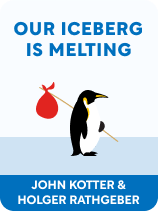

This article is an excerpt from the Shortform book guide to "Our Iceberg Is Melting" by John P. Kotter and Holger Rathgeber. Shortform has the world's best summaries and analyses of books you should be reading.
Like this article? Sign up for a free trial here .
What is John Kotter’s Our Iceberg Is Melting about? How does his story about penguins teach readers about, change, teamwork, and leadership?
In John Kotter’s book Our Iceberg Is Melting, he tells a fable about penguins who are faced with the reality that the iceberg they live on is melting and they must find a new home or perish. The story outlines the steps it takes and the difficulties companies face when they must adapt or die.
Below is a brief overview of Kotter’s fable Our Iceberg Is Melting.
Overview of Our Iceberg Is Melting
John Kotter’s Our Iceberg Is Melting is a fable about a colony of penguins who realize that their home might be destroyed soon, and that they need to move the entire colony to a new iceberg. However, despite the looming threat, making such a big change isn’t easy.
This book by Dr. John Kotter and Holger Rathgeber will teach you, through the penguin fable, the necessary steps in making major changes to your company or your personal life.
In this guide, we’ll explore some of the topics in greater detail and present alternative theories or points of view; we’ll provide the kind of in-depth study that a short story like Our Iceberg Is Melting has to forego in favor of simplicity and clarity in its lessons.
Step 1: Replace Complacency With Urgency
The first problem the characters needed to overcome was their colony’s false sense of security. They did this by convincing the others that there was an immediate, dire threat, and that they had to do something about it. In short, they created a sense of urgency to motivate the colony.
Sound the Alarm
The penguins had lived on the same Antarctic iceberg as far back as any of them could remember, and they saw no reason why that should ever change.
| Some argue that people are hard-wired to resist change; that millions of years of evolution have ingrained the instinct to accept “good enough” (which is to say, survival), rather than risk that stability to pursue something better. Furthermore, change is risky—the outcome is uncertain, and people don’t like uncertainty. To sum it up using a common idiom: People prefer the devil they know (the current situation) to the devil they don’t (change). |
However, a penguin named Fred made an alarming discovery: The iceberg was riddled with deep cracks due to Earth’s warming climate, and those cracks were filled with water. When winter came, that water would freeze and expand, which could shatter the whole iceberg.
Fred took his findings to Alice, one of the leaders of the penguin colony. Alice took Fred seriously, and arranged for him to present what he’d learned to the Leadership Council—including the Council head, a penguin named Louis.
It took some convincing, but eventually most of the Council members agreed that there was a dire threat to the colony, and that something had to be done. They began spreading the word to the other penguins.
What Fred and the Council accomplished here was replacing complacency with urgency. In other words, they convinced the colony that things were not normal, that they were in serious danger, and that they needed to take action to protect themselves from it.
| In order to make it clear why the penguins need to take action, the authors created a situation that was both extremely dangerous and easy to see: Namely, that the place the penguins lived was falling apart beneath their feet. Unfortunately, problems in real life aren’t always so visible or so immediate—you might have trouble convincing others that there even is a problem. Creativity, Inc. offers some suggestions on how to make your coworkers see the need for change, including: Discuss why you need to change (this is what Fred did in the penguin fable). Examine your current processes honestly, and look for problems. Accept—even embrace—the fact that the change may not go smoothly at first. Promise yourself and your coworkers that nobody will be punished for mistakes. |
Step 2: Make a Team
The next hurdle the penguins needed to face was figuring out who would actually solve the problem of the melting iceberg. Louis—the head of the Leadership Council—knew that protecting the colony was his responsibility, but he couldn’t possibly save the penguins on his own. Therefore, he assembled a skilled and qualified team to help him make the necessary changes.
(Shortform note: When you need to solve major problems, working with others is crucial. So why do so many people try to go it alone? It may be due to a lack of trust: One study suggests that only 32% of leaders worldwide believe their teams have the ability to meet their goals. We’ll discuss how to develop trusting teams below.)
Find the Right People
Besides himself, he chose four other penguins for the team, each with a unique personality and skill set. The final team was:
- Louis: An older penguin with the experience to make wise decisions. His position in the Leadership Council means that almost every penguin in the colony respects him (except for NoNo and some of the teenagers).
- Alice: Smart, practical, and driven. She’s an excellent project manager, treats everyone with respect (as shown by the fact that she listened to Fred), and isn’t intimidated by anyone.
- Fred: Younger than the others, but intelligent and curious. He was the first to notice the problem and bring it to the Council’s attention.
- Jordan, aka The Professor: Probably the smartest and most learned bird on the iceberg, though lacking in social skills.
- Buddy: Not exceptionally smart, nor a natural leader, but he’s a people-penguin who’s great at talking to people. Essentially the polar opposite of The Professor.
It would take all of them working together to make the kinds of changes that could save the colony.
| How to Choose the Right Team Members Louis assembled a skilled and qualified team, but qualifications weren’t the only factors he took into account. While skills and qualifications matter, team members’ personalities, values, and diverse experiences contribute to team success as well, and these can be hard to evaluate. One CEO recommends starting the search by focusing on three essential factors: humility, experience, and the “then vs. now” factor: Humility. Humility is crucial to the teamwork mentality—someone who thinks he’s better or more important than everyone else isn’t going to be an effective team player. Experience. You’ll need a mixture of experienced team members who can guide the organization through its change, and younger, less experienced team members who will be more flexible and open to new ideas. Adaptability. Your needs will change as your organization does. At first, you’ll need motivated and free-spirited people who can work well without strict guidelines. Then, as your changes solidify and become a permanent part of company culture, you’ll need people who can set down appropriate rules and abide by them. You can do this either by recruiting people who are willing and able to change their approach as time goes on, or by recruiting people with the understanding that they may be replaced as the project and the organization evolves. |
Step 3: Develop a Vision
The next problem the penguins ran into was the lack of a clear vision for the colony’s future. They knew that they needed to do something, but they didn’t yet know what they wanted to do. Therefore, their next step was to brainstorm solutions and pick the one that seemed most likely to work. In short, they needed a concrete plan before they started making any changes.
(Shortform note: The Leadership Challenge combines this step and the next (Spread the Word) into a single principle: Be Inspirational. In other words, both your vision and the way you communicate it are part of inspiring your colleagues to make the change that your organization needs.)
Decide on a Goal
The team of penguins started thinking about possible solutions to the expanding water inside the iceberg, and also asked other penguins in the colony for suggestions. However, none of the ideas they came up with were practical.
Eventually, a passing seagull landed on the iceberg, and Buddy and the Professor went to speak to it. They learned that the gull was a scout for a nomadic flock—the seagulls lived by constantly moving from one place to another, and this particular bird helped find places for the flock to go.
The visiting seagull gave the penguins an idea for a simple, practical solution: They would leave the iceberg.
| Seeking wisdom from unfamiliar sources, as the penguins did by befriending the seagull, does more than just give you new ideas—it boosts your ability to think creatively and improves your mood as well. In The Magic of Thinking Big, author and life strategist David J. Schwartz suggests finding friends and social groups with diverse backgrounds, religions, and political views. He describes such connections as “psychological sunshine”—both enlightening and enjoyable—and says that they’re part of building an ideal environment for yourself. |
Step 4: Spread the Word
The next challenge for the team was getting the rest of the colony onboard with their plan. The penguins all knew that there was a problem (remember step 1), but now they had to agree to the team’s solution. In short, the team needed to spread the word.
Get People Talking
Louis’s first step in spreading the word about their new vision was to call all of the penguins together for an announcement.
After Louis got the penguins’ attention with a dramatic opening speech, Buddy stepped forward to share what the team had learned from the seagull and their vision for the future.
By the end of the presentation, about a third of the colony was enthusiastic about the team’s vision for the future, while roughly 10% were completely opposed to it. The rest ranged from open-minded to skeptical about the plan.
As far as Louis was concerned, that was an excellent outcome for their first presentation.
| Ideas tend to spread through populations in a bell curve, sometimes known as the Idea Diffusion Curve. The theory behind the Curve is that a small percentage of the population—the Innovators and the Early Adopters—should be the actual target of any marketing that you do, because they’ll be the ones to spread your new idea or product to everyone else through word of mouth and social media. Therefore, having a third of the colony buying into their plan to migrate is a great start for the team. Presumably, those penguins are the Innovators and Early Adopters; the ones who will (with a bit of help from the team) get the rest of the colony onboard. |
Step 5: Make People Feel Important
Things had seemed to be going well for the penguins’ vision of a new, nomadic lifestyle, but unexpected problems started cropping up. The problems took a toll on the penguins’ energy and enthusiasm; many of them stopped attending meetings or working to get the colony ready. The plan, which had been going so well, now seemed doomed to fail.
As it turned out, the solution to almost all of the team’s problems was simply to make the other penguins feel involved.
For example, the colony’s schoolteacher had been telling her students horrific stories about penguins being eaten by whales or getting lost in the ocean. The team eventually discovered that she’d been doing so because she was afraid that she wouldn’t have a place in the colony after the move. The solution was to have Buddy talk to the teacher and reassure her that she’d still be needed in the new colony—if anything, she’d be even more important, as the young penguins tried to keep up with all the changes.
Once the schoolteacher felt important and empowered, she went on to solve the challenge of how to feed the scouts sent out to find a new home (they wouldn’t have time to hunt while scouting). In the process, she also made her students feel empowered. With the teacher’s guidance, the students put together a “Heroes Day celebration” in honor of the scouts, and charged each penguin two fish as the price of admission. Since most of the colony attended the celebration, they ended up with more than enough fish to feed all of the scouts.
| In this section, the penguin colony displays what author and mathematician Nassim Nicholas Taleb calls antifragility: becoming stronger after being damaged. The basis of antifragility is that people and (effective) systems overreact to hardship, and are thus better able to handle future hardships. Perhaps the simplest example is a weightlifter—he damages his muscles by lifting heavy objects, but once he recovers he’ll be able to lift even heavier ones. In a similar fashion, once the colony recovered from its problem with the schoolteacher, it became better than it was before; the newly empowered teacher went on to solve their other major problem of feeding the scouts. From this example, we can see how minor setbacks can lead you to major improvements. Therefore, don’t fear such setbacks or failures; instead, welcome them as chances to grow stronger. |
Step 6: Don’t Get Complacent
The last issue the team had to overcome was planning for the future. They’d successfully moved the colony to a new iceberg, and the penguins were safe—for the moment. However, there was always a chance that this iceberg would eventually be threatened too, or simply that another iceberg might be even better than the one they’d found.
Therefore, instead of deciding that their jobs were done, the team took steps to make sure the colony was always ready to move again if needed.
| Looking to the future and identifying potential threats is part of the commonly used SWOT analysis: Before making any major change at your company, evaluate its Strengths, Weaknesses, Opportunities, and Threats. Blockbuster Video is a prime example of the dangers of complacency and underestimating potential threats. In 2000, the video rental giant had a chance to buy Netflix for only $50 million. However, Blockbuster’s CEO was complacent—he thought that Netflix was a harmless novelty, rather than the future of the industry. He turned down the offer. In 2010, just 10 years later, Blockbuster declared bankruptcy. They’d been forced out of the market by delivery and streaming services, most notably Netflix itself. |
Never Stop Improving
Instead of just settling in on their new iceberg to continue life as usual, the penguins fully embraced their new, nomadic lifestyle—the scouts went out again and found an even bigger, better iceberg. The colony didn’t have nearly as much trouble moving a second time, because they’d grown used to change.
In the long run, the colony worked their new nomadic lifestyle into every aspect of their society. For example, the school started teaching scouting as a subject. Furthermore, the penguins decided that scouts should get extra fish as a sign of appreciation for their hard work—and, as a result, they had more volunteers than they knew what to do with.
However, as far as Louis was concerned, the single most remarkable change was how much the penguins had embraced the idea of change—they all understood that change was sometimes necessary, and they knew how to make it happen.
| The lesson from this final section is simple: Your job isn’t done just because you accomplished your goal. You have two things left to do:Make sure that the changes you’ve made are going to stick, like how the penguins reworked their society to include scouting education and incentives for future generations. Be ready to undergo this whole process again. The world is constantly changing; you must be ready to change along with it. |

———End of Preview———
Like what you just read? Read the rest of the world's best book summary and analysis of John P. Kotter and Holger Rathgeber's "Our Iceberg Is Melting" at Shortform .
Here's what you'll find in our full Our Iceberg Is Melting summary :
- A fable about the necessary steps in making major changes
- Dr. John Kotter’s eight-step process for change
- Why your job isn’t done just because you accomplished your goal






